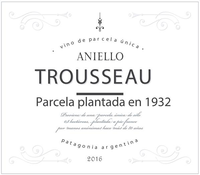 good story — an obscure red variety from the Jura region of France, itself an obscure area — and that the Aniello winery in Argentina has been garnering acclaim lately, particularly for its Pinot Noir. Tasting the wine simply sealed the deal.
good story — an obscure red variety from the Jura region of France, itself an obscure area — and that the Aniello winery in Argentina has been garnering acclaim lately, particularly for its Pinot Noir. Tasting the wine simply sealed the deal.
I am hardly expert in Trousseau. The handfuls of Trousseau wines I have tasted were all from the Jura in eastern France, an area of traditional winemaking, unusual styles of wine and native grape varieties such as the white Savagnin and the reds Poulsard and Trousseau. My limited experience told me that Trousseau wines tend to have high acidity, fine-grained tannins, and tart red fruit aromas and flavors. I found some Trousseau wines to be Pinot Noir-ish, assuming the Pinot Noir grew in a cool, high-altitude site; the combination of acid and tannin, along with fairly light color, reminded me of light Nebbiolo. These were not rich and intense reds, but rather had very much a cool-climate profile.
In the Patagonia region of Argentina, Aniello owns a vineyard of Trousseau that’s barely two acres in size. The vineyard was planted “by anonymous hands” in 1932, making it the oldest Trousseau vineyard in Argentina, and possibly the oldest in the world. At a latitude of 39 degrees south, the zone is distinctly cool climate, with long sunlight hours and significant diurnal temperature shifts — factors that bring ripeness and yet freshness to the wines.
The 2016 Aniello Trousseau is a fresh, lively, medium-bodied red with expressive and complex aromas and flavors. On the nose, you’ll find aromas of tart red fruits such as wild strawberries, red cherries, and cranberries, as well as notes of orange peel and vanilla blossom and a hint of green tobacco. In your mouth the wine is dry, with vivid flavors of red fruits and a suggestion of spiciness. The wine’s texture is enigmatic: smooth but not rich, light but not thin. Acidity lights the flavors from within, while the wine’s fine tannins provide just the slightest grip on your tongue and enhance the tartness of the fruity notes, which carry long on the finish.
The winemaking techniques used for this wine were fairly basic and non-interventionist: fermentation in small bins with ambient yeasts; malolactic conversion in used French oak barrels, and post-fermentation aging in egg-shaped concrete vats.
I love this wine for its energy, vitality, freshness of flavor and improbable structural balance. It’s the kind of red wine that I want right now, as warm weather sets in and we crave freshness and lightness in our food and drink. But remarkably for its style, it is not a frivolous wine. Mouthful after mouthful, you can ponder the flavors, the structural elements and the interaction of all the wine’s parts. Or, understandably, you could just drink it right down.
93 Points
